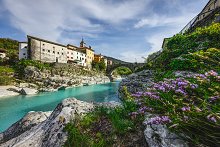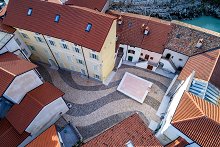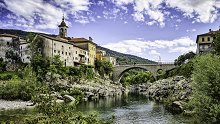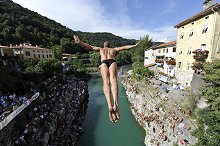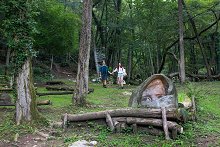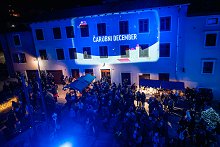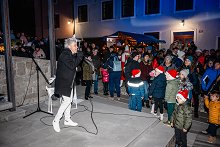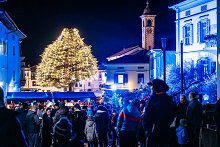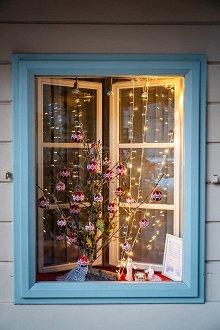The Bohinj Railway
The Bohinj Railway runs past Kanal. From March to including November inclusive it is possible to relive the drive aboard a steam locomotive (also known as the “Museum Train”).
The Bohinj Railway Line (Transalpina) is part of the 717-kilometre-long railway connection Prague-Jesenice-Gorizia-Trieste. It was built between 1900 and 1906 as the shortest connection between the Austro-Hungarian Monarchy and the Adriatic Sea (Trieste). The Bohinj line has a total of 28 tunnels, the longest being the Bohinj tunnel under Kobla (6327 m), five galleries and 65 bridges, making it one of the most attractive railway lines in Europe.
Before the First World War, the Bohinj Railway Line was used by 70 train compositions a day, coming from Prague, Munich and Vienna. It was damaged in several places during the First World War, including the Solkan Bridge over the Soča River, which was destroyed (and later rebuilt) and is renowned as the bridge with the largest stone arch in the world - 80 meters high. During the Second World War, traffic along the line was not possible, as the Germans blew up the northern portal of the Bohinj tunnel. After 1960, the line was modernised and the steam train stopped using the line in 1974. The Bohinj railway is a unique technical monument of the region, making its way through the Baška Grapa past Kanal towards Nova Gorica.
On its route through the municipality of Kanal ob Soči, it runs from the Most na Soči tunnel to the former Šmaver station, passing by the railway stations of Avče, Kanal, Anhovo and Plave.
The first part of the line, from the Most na Soči tunnel to Avče station, has four viaducts and six tunnels, including the Log tunnel - the seventh longest on the entire route. Avče station used to have four tracks, but today it is just a stop. Shortly after the station is one of the most beautiful viaducts on the entire route - the Mrtvaški viaduct.
The Avče Viaduct, or Mrtvaški viaduct, is 163 metres long, has seven arches, and its pillars barely touch the Soča River, which makes a sharp bend here. Under its first arch is the road that leads from Ročinj across the Soča to the village of Avče. The viaduct in Avče was named Mrtvaški (Dead Men’s) viaduct after the stream into which the inhabitants of the nearby hamlet of Škodniki used to throw the ashes of the clothes of fellow villagers.
From here on, towards Kanal station, there is a longer gallery and 17 culverts, bridges and viaducts, and the route leads past the Ajba reservoir. The bridge in Ajba is the first time the railway crosses the Soča River. The original bridge was made of stone. Its central part, with three 40-metre arches, rested on two stone pillars, which had their foundations in the river, and a third, which stood on the right bank of the river. At this point, the bridge began with another 30-metre-long arcade and ended on the left bank with two six-metre arches. At the entrance and exit of the bridge, two stone fortresses stood to protect this beautiful and strategically important structure. Although the former Ajba viaduct never enjoyed the same fame as the nearby Solkan bridge, it was also a unique construction achievement at the time. It was the longest railway bridge over a water barrier on the Austro-Hungarian railways and, at 252.50 metres, the third longest stone railway bridge in the world. Despite its defences, the bridge was damaged twice. In 1915, during the First World War, the Austrians destroyed the second, larger arch in an attempt to prevent the Italian army from advancing. After the war, the bridge was reopened to railway traffic with the help of an iron structure, and in 1925 it was finally rebuilt by the Italians and restored to its original shape. However, repeated bombardments during the Second World War proved fatal for the bridge. In 1944, the second rebuilt arch was again destroyed by British planes, the shelling continued and the once mighty and admirable stone beauty was completely destroyed by the end of the war. Immediately after the war, the English built an iron Roth-Waagner structure on top of the surviving pillars to allow emergency rail transport. In 1950, a new concrete bridge with six 25-metre arches began to be built alongside the old bridge, and was completed and opened for traffic in November 1954.
Before arriving at Kanal station, we cross the Kanal viaduct and tunnel. The Kanal railway station is 366.80 metres long and was built more lavishly than others in the Soča valley, due to its important role as a transport and tourist hub. The Kanal and St. Lucia stations were stops of the express train, intended for fast passenger transport from Vienna to Gorizia and Trieste and back. The station was badly damaged during the First World War, but the central building only suffered minor damage and was soon completely renovated. Today, it looks almost exactly as it did when it was built. Although most of the inhabitants of Kanal at the beginning of the 20th century were Slovenes, when the station was built it bore an Italian name as well as a Slovenian one. Between the two wars it was renamed Canale d' Isonzo, but after 1947 it again got a Slovenian name. Today, the station houses the Museum Collection 1914–1917 of the owner Zoran Šuligo. From Kanal, the route continues towards Anhovo railway station, where a large number of industrial tracks were built to meet industrial needs. En route from here to the Plave stop there are 14 culverts and one bridge. Between Plave railway station and the former Šmaver railway station there are two major tunnels (Plave and Vrhulj), two major galleries, numerous bridges and a viaduct. Šmaver station, which was built for the sole purpose of a train crossing area, has never really served as a passenger station, as there is no town in the vicinity. At Šmaver, the Bohinj railway leaves the municipality of Kanal ob Soči and crosses the famous Solkan Bridge towards Nova Gorica.
For tourist purposes, today you can take the museum train along the Bohinj line, which runs from May to November. Passengers are welcomed on board by a conductor wearing an old-stlye uniform and the sound of an accordion. The museum train is pulled by a steam locomotive of the Ljubljana Railway Museum, which is replaced by a diesel locomotive in the event a fire hazard is declared.
SOURCES:
– Kofol, K., Bohinj Railway Line, Tolmin Museum, http://www.tol-muzej.si/bohinjska-proga/si/, 2020.
– Petronio. P., Transalpina - Bohinj Railway Line, Slovenian Railways, 2000.
Foto: Damijan Simčič, Lucija Kavčič
